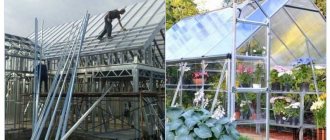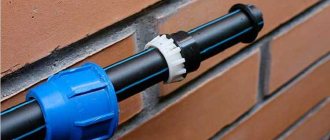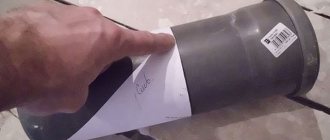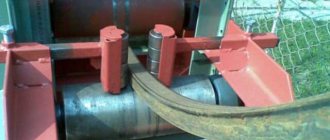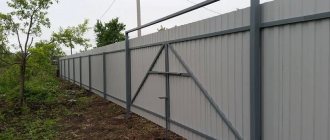When choosing a fence made of rolled metal, you need to know in advance at what distance the posts are placed from the fence, how profile pipes are connected by welding, and what fastening methods are most reliable. Each type of metal frame connection has its own characteristics that should be taken into account when performing work.
Welding profile pipe
Rules for connecting profile pipes
Most metal pipes used as a base for various objects are thin-walled. Working with them is highly complex and only qualified welders can perform it efficiently. Welding a profile thin-walled pipe for beginners will take place without any problems if beginners in this matter take into account a number of important features of the process, the main ones are:
- Current power. It should be within 10-60 A ;
- Correct choice of electrodes. For thin-walled metals, products with a diameter of 0.5-2 mm are suitable;
- Welding type. The pipes should be welded in one pass.
How to weld a profile pipe correctly and quickly? The quality of welding at the joint is determined primarily by how quickly the electrode moves along the joint line . It is recommended to finish welding the seam before the cooling process of the edges begins. You can form a seam with a tear using rutile electrodes.
You should not ignore the general rules that will help you weld a profile pipe without flaws, regardless of its thickness:
- Under the influence of high temperatures, deformation of the metal workpiece is possible. It must be taken into account that the profile is more susceptible to melting compared to round pipes;
- It is possible that the melt will get inside the pipe and completely fill it. Therefore, if it is necessary to maintain hollowness, you need to carefully monitor the condition of the internal walls of the workpieces;
- When creating an end connection, static stress in the corners is not excluded. The main reasons for its appearance are incorrectly formed rollers at the joint or uneven heating of the rolled metal.
For beginners, it is preferable to choose welding a profile pipe with an inverter. The use of an inverter machine allows high-quality welding of various metal alloys.
The essence and problems of bending profile pipes
Bending of metal products, regardless of the cross-sectional shape, consists of giving them a partial or complete smoothly curved configuration. One of the common plumbing procedures is performed either under pressure alone, or under pressure in combination with heating the bending area. At this time, the processed part of the hollow metal workpiece is simultaneously subject to compression forces from the inside of the workpiece and tensile forces along the outer wall. Complications are that:
- During the process of changing shape, the material may lose the alignment of the segments, i.e. parts of the curved workpiece will not be located in a single plane;
- the stretchable outer wall in the bending area may not withstand the impact and simply burst;
- The compressed inner wall may, instead of uniform contraction, fold into folds resembling a corrugation.
Without knowing the intricacies of bending a profile, there is a risk of simply crushing the product, ruining the workpiece. But recklessness is not our way! Especially if it is accompanied by material losses. For the glory of rational economy, we will take into account all the vagaries of the profile and characteristics of the “iron” material. Let's not forget about the cross-sectional dimensions, the wall thickness of the profile pipe, the required bending radius and the elasticity of the steel alloy. Based on the specified parameters, we will choose the correct technological path - also known as the bending method.
Equipment for welding profile pipes
Equipment for welding
To weld a profile pipe, you need to prepare a set of equipment. For manual welding, an inverter-type device, or rectifiers and generators that provide direct current, are best suited. In addition to the inverter, the welder may need gas devices - hoses, cylinders, torches, gearboxes, devices for supplying consumables. Gas equipment is not required if cored wire is used.
We must also not forget about personal protective equipment, brushes, and hammers. Magnetic corners, clamps, and clamps help to position the workpieces in the desired position . It would be useful for professional welders to purchase a centralizer, with which they can quickly align the ends of the profile and fix them.
Welding work
Experts believe that the easiest way to insert into a steel external network is welding. A prerequisite for insertion is the ability to turn off the water supply to the system.
An autogenous tool is used to make a hole of a suitable diameter. Then the pipe is welded and the valve is mounted. The last element of the system is covered during further work. If the tapping is completed, the anti-corrosion protection will need to be restored.
If the pipeline is laid from polyethylene pipes, then welding work is not carried out. Taking into account the diameter of the consumable, the clamp is fixed.
Welding methods
You should determine in advance which electrodes and how to weld the profile pipe. There are several methods for joining workpieces by welding, each of them has its own characteristics, which determine the choice of pipe joining option.
Manual arc welding
One of the simplest methods to get an even seam. A transformer or inverter welding machine is suitable for the job. Arc welding is suitable for connecting profiles with different wall thicknesses and section sizes. If the thickness is more than 4 mm , then the edges of the workpiece are protected and degreased.
diameter of 2.3 mm are needed; the current on the device is set in the range from 50 to 60 A. The arc method allows welding horizontally, vertically and even from below.
Welding for beginners video
Features of electric welding
Welding is performed using non-consumable (tungsten) electrodes. The rod is placed at a short distance from the bath, this will allow the formation of a dense, continuous seam with a short arc.
The diameter of the electrode is selected based on the thickness of the profile. If its walls are no more than 2 mm thick, then a rod with a diameter of 1 mm will be required. If the workpieces to be connected are thicker, then it is better to take an electrode with a diameter of 1.6 mm. The filler wire is selected in a similar way, that is, it must match the thickness of the material being welded or be slightly thicker.
For electric welding you will need a transformer, an inverter, a power supply, and equipment for supplying shielding gas. The consumption of argon or other gas should be no more than 12 liters per minute, the current strength depends on the thickness of the profile and can be in the range of 50-120 A . You need to finish cooking by reducing the voltage. The gas is shut off 10-20 seconds after the current supply is stopped.
Gas welding
Welding using gas equipment is no different from other methods. The desired area is heated, after which filler wire is applied to it. Melting, the rod fills the joint. The rod is moved strictly in the direction of the joint; depending on the chosen method, two gas welding technologies are distinguished:
- From left to right . The additive moves behind the burner, so the working area is optimally heated. In this case, the welder can constantly monitor the process. This method is considered the most suitable when welding profiles with a thickness of 5 mm or more;
- From right to left . When choosing this method, workpieces burn out extremely rarely, but it is suitable for connecting only thin-walled profiles.
After the seams have cooled, it is advisable to clean them and coat them with an anti-corrosion agent.
Important! The edges of corrugated pipes with walls up to 4 mm thick should not be formed.
How to properly weld metal using gas welding video
Using resistance welding
More suitable for enterprises, as it requires the use of expensive equipment and is characterized by increased complexity. No filler materials are used during resistance welding. Welding of workpieces occurs under high pressure electrodes with simultaneous exposure to voltage at the joining point. This leads to the melting of the metal and the formation of a homogeneous medium, which turns into a monolith after cooling. That is, the resulting connection has the highest margin of safety.
Resistance welding video
Welding with inverter
A type of arc welding using an inverter welding machine. The inverter is suitable for welding profiles of different thicknesses. The operating mode of modern models is pulse. 2 mm thick profile pipe , you need a current of 50 to 60 A. Thick-walled rolled products are connected using a more powerful electric current.
The work uses a coated additive. When the arc is excited, it begins to burn, which leads to melting of the coating. Part of it goes into molten rolled metal and part of it is converted into gas. Due to this, the welding zone does not come into contact with air. Inverter machines ensure smooth and high-quality seams.
Welding inverter video
How is the calculation done?
To figure out the number of cuts, you need to perform a simple calculation. Let's assume that the following conditions need to be met:
- there is a pipe measuring 30·50 mm;
- a turn at an angle of 180 ⁰ is required;
- full turning radius R = 100 mm;
- movement is carried out along the wall b = 30 mm.
It is necessary to determine the outer length of the formative half of the circle.
Lnar = π (R + b)/2
here π = 3.14 is the ratio of the circumference to the radius.
Along the way, half of the generatrix is determined along the internal radius.
Lin = π R/2
The difference between the values determines the overall width of the cuts.
C = Lout – Lin
Knowing the thickness of the saw blade (h = 2 mm), it is easy to determine the number of cuts.
n = C/h
All that remains is to substitute all the data into the calculation formula and determine the number of cuts for a 90⁰ rotation. The total quantity can be determined as:
N=2n
Calculation scheme for determining the parameters of cuts
It is better to present the calculation in the form of table 1
Table 1. Determination of the number of cuts for initial conditions
| Pipe width b, mm | 30 |
| Radius of the inner layer R, mm | 100 |
| Outer radius R out, mm | 130 |
| Length of half a circle along the outer layer Lout, mm | 408,2 |
| Half-circle length along the inner layer Lin, mm | 314 |
| Difference between the length of the outer and inner layer C, mm | 94,2 |
| Cutting width h, mm | 2 |
| Number of cuts n | 47 |
| Total number of cuts N | 94 |
People who want to build a greenhouse often ask about bending pipes using cuts. They are interested in: “How many times do you need to saw through the walls to obtain a bend with a certain radius of the generatrix?” Using the proposed dependencies, you can easily calculate the pipe grooves for the greenhouse. Table 2 shows calculations for pipes of different diameters and radii of the internal generatrix.
Table 2. Calculation for greenhouse profile pipes
| № | Pipe width b, mm | Radius of the inner layer R, mm | Outer radius R out, mm | Length of half a circle along the outer layer Lout, mm | Half-circle length along the inner layer Lin, mm | Difference between the length of the outer and inner layer C, mm | Cutting width h, mm | Number of cuts n | Total number of cuts N |
| 1 | 20 | 1000 | 1020 | 3202,8 | 3140 | 62,8 | 2,4 | 26 | 52 |
| 2 | 25 | 1000 | 1025 | 3218,5 | 3140 | 78,5 | 2,4 | 33 | 66 |
| 3 | 30 | 1000 | 1030 | 3234,2 | 3140 | 94,2 | 2,4 | 39 | 78 |
| 4 | 35 | 1000 | 1035 | 3249,9 | 3140 | 109,9 | 2,4 | 46 | 92 |
| 5 | 40 | 1000 | 1040 | 3265,6 | 3140 | 125,6 | 2,4 | 52 | 104 |
| 6 | 20 | 1250 | 1270 | 3987,8 | 3925 | 62,8 | 2,4 | 26 | 52 |
| 7 | 25 | 1250 | 1275 | 4003,5 | 3925 | 78,5 | 2,4 | 33 | 66 |
| 8 | 30 | 1250 | 1280 | 4019,2 | 3925 | 94,2 | 2,4 | 39 | 78 |
| 9 | 35 | 1250 | 1285 | 4034,9 | 3925 | 109,9 | 2,4 | 46 | 92 |
| 10 | 40 | 1250 | 1290 | 4050,6 | 3925 | 125,6 | 2,4 | 52 | 104 |
| 11 | 20 | 1500 | 1520 | 4772,8 | 4710 | 62,8 | 2,4 | 26 | 52 |
| 12 | 25 | 1500 | 1525 | 4788,5 | 4710 | 78,5 | 2,4 | 33 | 66 |
| 13 | 30 | 1500 | 1530 | 4804,2 | 4710 | 94,2 | 2,4 | 39 | 78 |
| 14 | 35 | 1500 | 1535 | 4819,9 | 4710 | 109,9 | 2,4 | 46 | 92 |
| 15 | 40 | 1500 | 1540 | 4835,6 | 4710 | 125,6 | 2,4 | 52 | 104 |
To assess the effectiveness of such technology, it is advisable to estimate the labor intensity and costs of materials (Table 3).
Table 3. Labor costs and cost of consumables for bending arcs for a greenhouse
| Number of cuts | Duration of one cut, min | Total duration of pipe sawing, min | Consumption of cutting discs with a diameter of 125 mm, pcs. | Total consumption of cutting wheels, pcs. | Duration of bending along the grooves, min | Duration of welding a seam along a cut, min |
| 52 | 0,3 | 15,6 | 0,2 | 10,4 | 0,3 | 1,3 |
| 66 | 0,3 | 19,8 | 0,2 | 13,2 | 0,3 | 1,3 |
| 78 | 0,3 | 23,4 | 0,2 | 15,6 | 0,3 | 1,3 |
| 92 | 0,3 | 27,6 | 0,2 | 18,4 | 0,3 | 1,3 |
| 104 | 0,3 | 31,2 | 0,2 | 20,8 | 0,3 | 1,3 |
| — | — | — | — | — | — | — |
| Number of cuts | Total duration of welding grooves, min | Electrode consumption 3 mm per groove on three sides | Total electrodes required, pcs. | Total process duration, min | Total duration of the process, hour | Given costs for the purchase of disks and electrodes, rub. |
| 52 | 67,6 | 0,25 | 13 | 83,5 | 1,39 | 322,4 |
| 66 | 85,8 | 0,25 | 16,5 | 105,9 | 1,77 | 409,2 |
| 78 | 101,4 | 0,25 | 19,5 | 125,1 | 2,09 | 483,6 |
| 92 | 119,6 | 0,25 | 23 | 147,5 | 2,46 | 570,4 |
| 104 | 135,2 | 0,25 | 26 | 166,7 | 2,78 | 644,8 |
How much does one steel profile pipe of size 20·20 mm cost? According to the latest data, a six-meter section can be purchased at a price of 320...360 rubles. It turns out that the cost of the process will cost about the same as the pipe itself costs. In this case, you will have to spend more than an hour and a half on one arc. The appearance of the finished products is far from perfect. To give it a marketable appearance, it is necessary to grind using an abrasive tool. This operation is comparable in time to the costs of welding work. Flap wheels will further increase direct operating costs.
Type of bent products obtained by cutting grooves followed by welding
From the presented calculations it is clear that the technology of bending pipes along a radius can be justified only for bending profile workpieces only in limited quantities. If you need to create a complex spatial structure, you should use special devices for industrial bending.
When sawing grooves, it is necessary to control the depth of cut on all three sides. A special device will be required that can limit the entry of the tool as the disk is ground down.
What electrodes are used for profile welding
Profile pipes are most often made of carbon or low-alloy steel. The following electrodes are most suitable for welding:
- ANO-4 . Universal and most popular type of electrodes. Suitable for various types of devices, does not require pre-calcination;
- OZS-12 . Allows you to obtain a high quality seam. But electrodes of this brand are not characterized by increased moisture resistance;
- UONI-13/55 . The best electrodes for forming a strong connection;
- MR-3S . They are rarely used and mainly in situations where the quality of the seam must be ideal.
Which electrodes are preferable for welding a fence from a profile pipe? As practice shows, it is easier for beginners to use brands such as MP-3, OZS-12. They contain rutile, which simplifies the initial stage of welding, and the joints are strong and resistant to moisture.
Advice! The necessary skills can be obtained by practicing welding various pipe scraps.
Carrying out work
Before starting welding work, you need to put on overalls, prepare a welding mask and gloves. Prepare the welding area. Remove all flammable items. You will need a metal brush to clean the surface of the pipe and a hammer to knock off the slag. And, of course, the welding machine itself, and correctly selected electrodes.
When purchasing electrodes, read the instructions on the package. The manufacturer shows on its product the operating rules and purpose of this type of electrodes. The electrode diameter and current strength are selected by calculation. For any 1 mm of electrode thickness, a current of 30 to 40 amperes is required. As for inverter welding machines, in this case for a 3 mm electrode the required current strength will be 80 A. These parameters are suitable for welding metal, but for cutting it you need to increase the current strength to 100 A.
You need to start the work by securing both pipes in order to avoid displacement of the seam. Light an arc with the electrode inserted into the holder and try to weld a small area. The electrode should have an inclination angle of 70? in relation to the surface to be welded and a gap of about 2–4 mm. It is immediately necessary to make a reservation that these indicators are very approximate and only experience will advise the optimal values in a particular case.
Before you decide to carry out work, you need to prepare as much as possible. It would not be superfluous to study the theoretical side of the issue, or watch relevant videos, or individual consultations with experts.
Butt welding
The butt profile is especially difficult to weld. A number of tips from experienced welders will simplify the task:
- The workpieces need to be grabbed at the corners of the section. Then the joining is checked, if there is an error, it is corrected, and only after that they start welding around the perimeter;
- Thin-walled pipes are connected in one pass; thick-walled pipes require 2 or more;
- The arc speed must be such that the edges of the workpieces melt, but the metal does not sag;
- Finish the work so that the first overlap and the edge of the seam coincide.
Method of welding profile pipe video
Application of the hot method
A blowtorch, a hair dryer turned on at maximum heating temperature, or a gas burner are suitable for heating metal. Sand is used as a filler. It prevents rupture of the walls during bending, the appearance of dents and bulging of the metal. To prevent the filler from spilling out, it is recommended to install temporary plugs at the ends.
Important! It is necessary to monitor the glow temperature; overheating can cause the metal to melt. The method is suitable for pipes with a cross-section over 10 cm.
Let's look at how to bend a pipe at home without an aluminum pipe bender. A sheet of paper is brought to the heated surface. If it ignites, heating should be stopped. An indicator of sufficient heating on steel structures is redness to the state of scale. It should be remembered that the metal heats up along its entire length, so the work must be done with rubber gloves.
Welding profile at 90 degrees
Welding profile pipes at an angle of 90 degrees is ideal only with practical experience. But there are a number of technical points, observing which you can simplify the process of obtaining a right angle:
- Pipes should be cut as carefully as possible;
- The workpieces are joined and tacked only on a flat surface;
- For fixation, devices are used that allow maintaining a stable right angle. Most often these are spacers, squares and gussets.
First, a rough connection of the parts is necessary. If the angle is maintained at the first stage, then final welding is carried out.
Bending pipes without radius
When creating a spatial frame, designers are faced with the need to manufacture elements in which it is necessary to create parts where sections of pipes are connected to each other at a right angle (90 degrees) or at an acute angle (45 degrees, for example). You can cut the pieces and then weld them together. However, the issue can be solved in another way:
- Make markings for the future cutout.
- Cut out excess metal.
- Perform a bend, connecting the edges of the cut made. Weld the metal along the edges.
Scheme of the technical process of bending at right angles with trimming: 1 – marking; 2 – cutting out excess metal; 3 – bending and welding of edges
This method will allow you to obtain a fairly strong part, in which part of the metal remains intact.
If you do not trim, then the excess metal has nowhere to go. The result is an unattractive appearance of the product.
Direct bending of a profile pipe without trimming
What is the reason for this phenomenon? To understand how simple bending occurs, you should consider the diagram.
Scheme of bend formation in pipes
If a suitable mandrel is available, bending is performed:
- One end is fixed motionless.
- The surface of the workpiece rests against the base surface, relative to which the second end will be moved.
- Force is applied and a new surface is formed.
Inside you can see the central line along which the pipe is bent.
Similar phenomena occur not only in hollow products. Even in solid parts, when layers are displaced relative to each other, similar phenomena occur.
Welding of professional pipe
Profile pipes are connected by vertical, horizontal and so-called ceiling seams. Each of these options is selected depending on the tasks and design features.
Vertical seam
To obtain a vertical seam, the electrode is held at an angle forward. Stages of work:
- If workpieces of different thicknesses are connected, the arc is ignited on the one that is thicker. The electrode should be moved from bottom to top;
- With minimal delay, the rod moves to the second workpiece;
- After this, the arc can be broken and moved higher along the joint. However, experienced welders continue to form the seam, making uniform oscillatory movements.
Seam with ceiling position
The technique is similar to creating a vertical connection. You can periodically tear off the electrode, welding the workpieces using the spot method. If the seam is laid without tearing, it is recommended to use the tip of the rod to make circular movements of small amplitude.
The angle of the electrode is directed towards the pipe whose walls are thicker. separation should be 75-95 A , without separation from 65 to 75 A.
Features of the horizontal seam
If you need to weld a square from a profile pipe, then you cannot do without horizontal seams. Welding begins with a vertically positioned workpiece, since its heat dissipation is higher, and this reduces the likelihood of metal burning. The electrode is tilted towards the vertical post.
If the continuous cooking method is selected, the electrode must be moved without oscillating movements.
Difficulties of the process
All metal material may be partially or entirely bent. The inversion process is carried out in two ways:
- mechanical impact;
- heating the metal.
In the first case, the metal has to be bent without heating. This method is better because the metal does not lose its properties. However, without heating the material it will be very difficult to bend the metal. When heated, it is much easier to bend, but the metal may lose its properties and become less durable.
A round metal product has approximately even characteristics. However, the profile pipe has an angle of 90°. This angle of the pipe prevents smooth bending, resulting in various folds that can subsequently burst or break.
In order not to spoil the metal, you need to clearly know how to bend a profile pipe at home. Many summer residents, not knowing the sensitivity of bending, waste a lot of material, which is subsequently thrown away.
If you examine professional equipment, you will notice that inside the rolling roller there is a special groove that presses through the middle of the wall of the profile pipe. This helps because the inner edge is compressed and there are fewer folds.
Sector welding
Often people do not know how to bend a stainless steel pipe, since stainless steel is a stronger alloy than regular steel. Of course, thanks to professional equipment this is easy to do. But what if there is nothing at hand that can provide sufficient mechanical pressure? It is for this purpose that sector welding was invented.
Its principle is that the profile product is sawed off on one side at equal distances , after which the material is bent in the required direction and the slots are welded. In this case, it is important to know that the corrugated pipe is most often thin-walled and when the slots are nearby, it is very easy to burn through it.
People who have little experience working with a tool often miss cuts, making them either too frequent or rare. To make sure the markings are correct, you can take another elastic square material and use it as a template.
If you have a gas burner on hand, the profile material can be bent using heat. Once the metal gets hot, it becomes more easily distorted, which helps prevent creases on the inside of the wall. If the bending radius is small, then you can get by with a regular clamp. But if a more precise bend is required, a guide wall will be required.
Using sand
To make a product from a bent profile pipe, you can use sand. The end of the material is tightly closed with a special plastic or copper sleeve. After this, fine sand is poured into the pipe. It is important that the product is completely filled with sand . Since the empty space inside the pipe is now tightly packed, the material will be much more easily subject to mechanical bending. The main thing is to initially create a standard according to which you can bend and guide the product.
Bend in the tree
This method is relatively often used if the pipe diameter does not exceed 15 mm. For bending to be successful, the end of the material must be tightly secured. But what to do if you can’t hold the material with your hands, and there are simply no other fastening points anywhere? And for this, the handymen came up with a fastening method. Surely there may be trees on all dacha plots. It is the tree that can serve not only as a strong fastening, but also as a diameter for bending the profile pipe.
